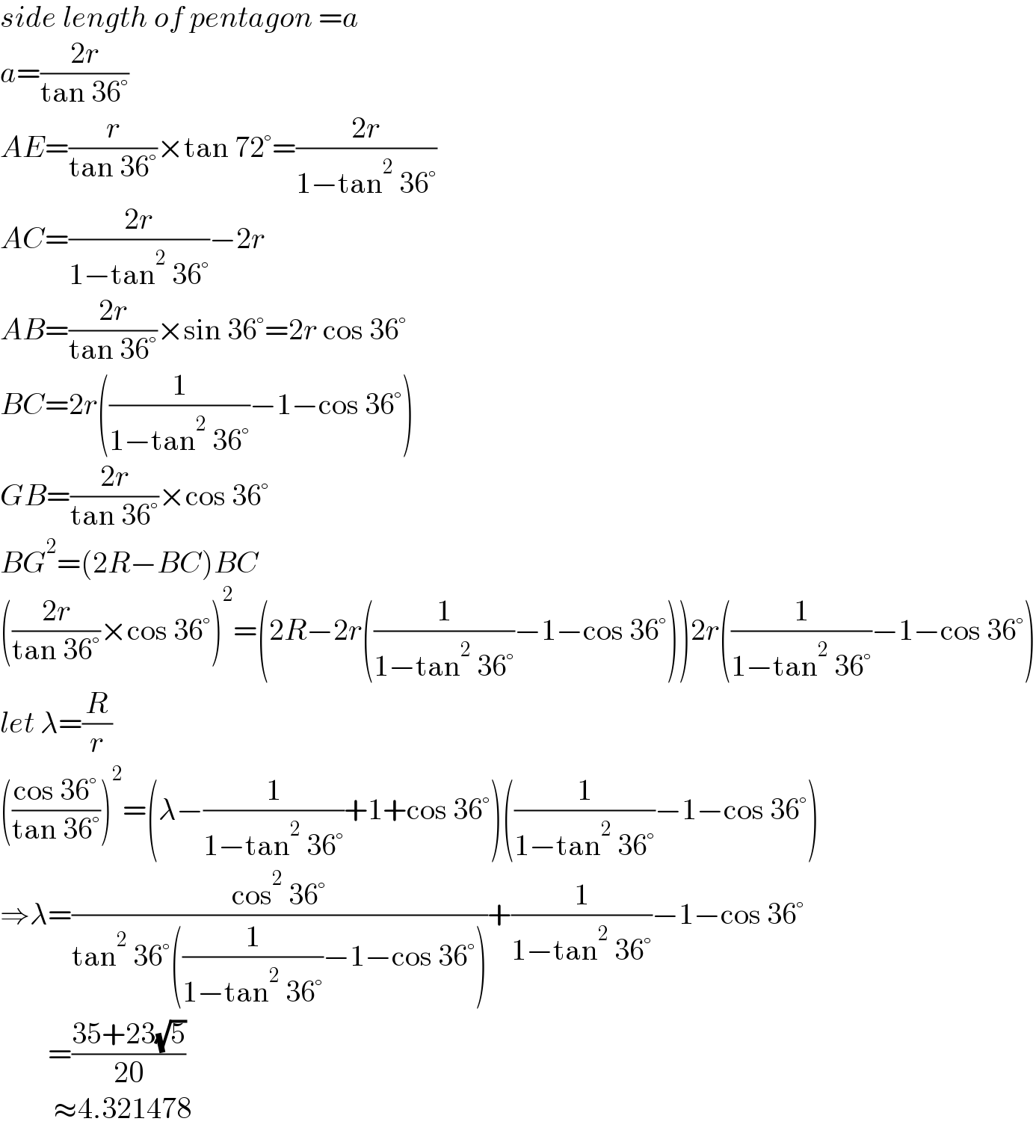Question Number 128944 by ajfour last updated on 11/Jan/21

Commented by ajfour last updated on 11/Jan/21

$${Find}\:{radius}\:{ratio}\:\frac{{R}}{{r}}. \\ $$$${The}\:{polygon}\:{is}\:{a}\:{regular} \\ $$$${pentagon}. \\ $$
Answered by mr W last updated on 11/Jan/21

Commented by mr W last updated on 11/Jan/21

$${side}\:{length}\:{of}\:{pentagon}\:={a} \\ $$$${a}=\frac{\mathrm{2}{r}}{\mathrm{tan}\:\mathrm{36}°} \\ $$$${AE}=\frac{{r}}{\mathrm{tan}\:\mathrm{36}°}×\mathrm{tan}\:\mathrm{72}°=\frac{\mathrm{2}{r}}{\mathrm{1}−\mathrm{tan}^{\mathrm{2}} \:\mathrm{36}°} \\ $$$${AC}=\frac{\mathrm{2}{r}}{\mathrm{1}−\mathrm{tan}^{\mathrm{2}} \:\mathrm{36}°}−\mathrm{2}{r} \\ $$$${AB}=\frac{\mathrm{2}{r}}{\mathrm{tan}\:\mathrm{36}°}×\mathrm{sin}\:\mathrm{36}°=\mathrm{2}{r}\:\mathrm{cos}\:\mathrm{36}° \\ $$$${BC}=\mathrm{2}{r}\left(\frac{\mathrm{1}}{\mathrm{1}−\mathrm{tan}^{\mathrm{2}} \:\mathrm{36}°}−\mathrm{1}−\mathrm{cos}\:\mathrm{36}°\right) \\ $$$${GB}=\frac{\mathrm{2}{r}}{\mathrm{tan}\:\mathrm{36}°}×\mathrm{cos}\:\mathrm{36}° \\ $$$${BG}^{\mathrm{2}} =\left(\mathrm{2}{R}−{BC}\right){BC} \\ $$$$\left(\frac{\mathrm{2}{r}}{\mathrm{tan}\:\mathrm{36}°}×\mathrm{cos}\:\mathrm{36}°\right)^{\mathrm{2}} =\left(\mathrm{2}{R}−\mathrm{2}{r}\left(\frac{\mathrm{1}}{\mathrm{1}−\mathrm{tan}^{\mathrm{2}} \:\mathrm{36}°}−\mathrm{1}−\mathrm{cos}\:\mathrm{36}°\right)\right)\mathrm{2}{r}\left(\frac{\mathrm{1}}{\mathrm{1}−\mathrm{tan}^{\mathrm{2}} \:\mathrm{36}°}−\mathrm{1}−\mathrm{cos}\:\mathrm{36}°\right) \\ $$$${let}\:\lambda=\frac{{R}}{{r}} \\ $$$$\left(\frac{\mathrm{cos}\:\mathrm{36}°}{\mathrm{tan}\:\mathrm{36}°}\right)^{\mathrm{2}} =\left(\lambda−\frac{\mathrm{1}}{\mathrm{1}−\mathrm{tan}^{\mathrm{2}} \:\mathrm{36}°}+\mathrm{1}+\mathrm{cos}\:\mathrm{36}°\right)\left(\frac{\mathrm{1}}{\mathrm{1}−\mathrm{tan}^{\mathrm{2}} \:\mathrm{36}°}−\mathrm{1}−\mathrm{cos}\:\mathrm{36}°\right) \\ $$$$\Rightarrow\lambda=\frac{\mathrm{cos}^{\mathrm{2}} \:\mathrm{36}°}{\mathrm{tan}^{\mathrm{2}} \:\mathrm{36}°\left(\frac{\mathrm{1}}{\mathrm{1}−\mathrm{tan}^{\mathrm{2}} \:\mathrm{36}°}−\mathrm{1}−\mathrm{cos}\:\mathrm{36}°\right)}+\frac{\mathrm{1}}{\mathrm{1}−\mathrm{tan}^{\mathrm{2}} \:\mathrm{36}°}−\mathrm{1}−\mathrm{cos}\:\mathrm{36}° \\ $$$$\:\:\:\:\:\:\:\:=\frac{\mathrm{35}+\mathrm{23}\sqrt{\mathrm{5}}}{\mathrm{20}} \\ $$$$\:\:\:\:\:\:\:\:\:\approx\mathrm{4}.\mathrm{321478} \\ $$
